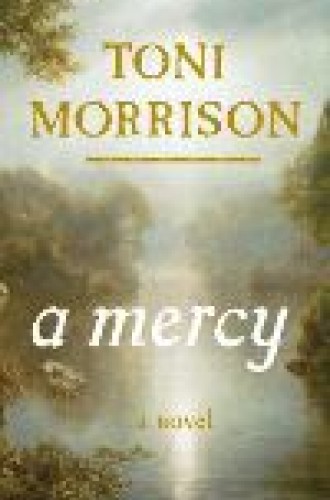A Mercy
Toni Morrison’s novel A Mercy begins with a Sophie’s Choice moment for a slave woman living in Barbados in the late 17th century. Her master owes a debt to a trader, and he offers the woman’s infant son as collateral. She pushes her preadolescent daughter toward the trader and begs him to take the girl instead.
The daughter, Florens, believes that her mother has chosen the boy’s life as more important than her own, and the memory of her mother’s rejection haunts her. She travels to Maryland with the trader and settles on his farm in the company of three other women. Each of these women has faced some sort of abandonment or exile, and all of their stories are told in this slim but dense novel. The trader’s wife, Rebekka, was sent to the New World by her family to marry an unknown man. Rebekka’s servant and closest friend, Lina, is a native woman who lost her family to disease. Sorrow is a young woman who was found shipwrecked and who knows almost nothing of her family or origins. Together these women form a fragile involuntary community.
Most of the novel takes place some years after the arrival of Florens. The trader has sickened and died, and his wife, who is ill herself, sends Florens to find the one man she believes can save her, a free blacksmith who helped her husband build his house and whom she believes has the power to heal. Florens obeys, but with a motivation of her own: she is in love with the blacksmith.
Rather than a single coherent story, A Mercy is a collage of prerevolutionary America, where far more people are conscripts or orphans than are heroes, pilgrims or pioneers. Certainly the lack of a coherent, continuous plot will frustrate some readers. Just as you think the story is taking off, you turn back again to the past, to the history of another in the menagerie of characters. These stories are tangled and partial. They demand patience on the part of the reader.
But patience is rewarded. A Mercy is a meditation on the nature of slavery and freedom, on where we came from and who we are. Morrison writes about a moment when racial identity had yet to solidify and polarize into black and white, and she uses this moment to transform slavery from a historical problem into a question about human nature. Slavery, in this novel, has both external and internal components. It isn’t merely a legal status; it is also a way of encountering the world. The trader, for example, should be the most free of the characters in the book because he is a European man who can own property and other humans. But he is enslaved to an idea of prosperity that costs him his life.
Florens’s quest for freedom is the most complex. As she searches for the blacksmith, she is enslaved by her desire for him in a way that destroys what connection she has to the other women on the farm. But the blacksmith tells her that her slavery is her choice. She objects that being owned by the trader is what makes her a slave. He says that she is a slave because “your head is empty and your body is wild.” She proposes that she is enslaved to the blacksmith out of love. He rejects her and replies, “Own yourself.”
Florens follows his directive and turns herself, in the observation of two indentured servants who live near the trader’s farm, from “have me always” to “don’t touch me ever.” She defies Rebekka and takes up residence in the house that the trader had been trying to finish before his death. There she begins to author her own story. Morrison seems to argue that while slavery is a hard condition to be in, finding internal freedom is still harder. Morrison says that wresting “dominion over another is a wrong thing” (presumably the sin of the slave owner), but giving “dominion of yourself to another” is “wicked.”
But what exactly is freedom and what are its benefits? Florens’s search for freedom leaves the fragile community of women on the farm destroyed, as if without Florens “each woman embargoed herself; spun her own web of thoughts, unavailable to anyone else.” The cost of freedom is terrible if it means having no link to others. “Don’t touch me ever” may have something to recommend it, but inviolacy is another kind of prison.
Morrison doesn’t give us an answer to this problem. Instead she gives us tiny glimpses into alternative ways to be human together. We see a group of escaped slaves living in the woods and finding strength, comfort and protection in their voluntary solidarity. Rebekka’s story involves recollection of the women with whom she traveled to Maryland, a group of “exiled, thrown-away” women who teach and help each other, who “lightened the journey, made it less hideous than it surely would have been without them.” Maybe, in Morrison’s imagination, this is the best we can do for each other. Utopia is the only place where a person can be both truly free and truly loved. If the women on the farm would only choose each other, they would find freedom, friendship and connection in abundance. Morrison provides a hint of what this would look like, and also of why it can’t be so. Both exile and slavery are produced by historical and social elements, and they cannot be overcome simply by will or desire.





